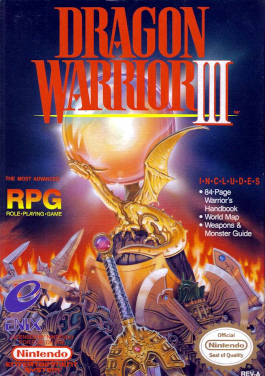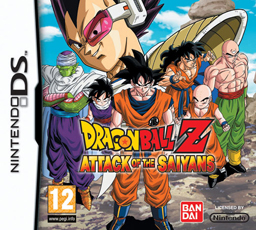Dragon Quest, previously published as Dragon Warrior in North America until 2005, is a series of role-playing games created by Japanese game designers Armor Project, Bird Studio and Sugiyama Kobo to its publisher Enix, with all of the involved parties co-owning the copyright of the series since then. The games are published by Square Enix since its inception, with localized remakes and ports of later installments for the Nintendo DS, Nintendo 3DS, and Nintendo Switch being published by Nintendo outside of Japan. With its first game published in 1986, there are eleven main-series games, along with numerous spin-off games. In addition, there have been numerous manga, anime and novels published under the franchise, with nearly every game in the main series having a related adaptation.

The Mana series, known in Japan as Seiken Densetsu, is a high fantasy action role-playing game series created by Koichi Ishii, with development formerly from Square, and is currently owned by Square Enix. The series began in 1991 as Final Fantasy Adventure, a Game Boy handheld side story to Square's flagship franchise Final Fantasy. The Final Fantasy elements were subsequently dropped starting with the second installment, Secret of Mana, in order to become its own series. It has grown to include games of various genres within the fictional world of Mana, with recurring stories involving a world tree, its associated holy sword, and the fight against forces that would steal their power. Several character designs, creatures, and musical themes reappear frequently.
Jaleco Ltd. was a corporate brand name that was used by two previously connected video game developers and publishers based in Japan. The original Jaleco company was founded in 1974 as Japan Leisure Company, founded by Yoshiaki Kanazawa, before being renamed to simply Jaleco in the early 1980s. This company was later acquired in 2000 by PCCW, who rebranded it as their Japanese game division, PCCW Japan, before reverting it to Jaleco in 2002. In 2006, Jaleco became independent from PCCW and renamed to Jaleco Holding, having their video game operations spun off into a new company, also called Jaleco. This new spin-off company was sold to mobile developer Game Yarou in 2009, with Jaleco Holding renaming itself to Encom Holdings shortly after.
Enix Corporation was a Japanese multimedia publisher who handled and oversaw video games, manga, guidebooks, and merchandise. It was founded in 1975 by Yasuhiro Fukushima as Eidansha Boshu Service Center, initially as a tabloid publisher and later attempting to branch into real estate management. Beginning in 1982, Enix began publishing video games. Three notable early collaborators were designers Yuji Horii and Koichi Nakamura, and composer Koichi Sugiyama. Horii, Nakamura and Sugiyama would all work on the 1986 role playing video game (RPG) Dragon Quest for the Family Computer; one of the earliest successful RPGs for consoles, it spawned a franchise of the same name which remains Enix's best-known product.
Dragon Quest Monsters is a spin-off series of the Dragon Quest games. Primarily developed by Tose and published by Square Enix, it sets the player in a medieval/fantasy world filled with magic, monsters and knights. Unlike the original Dragon Quest games, the player's character does not do any of the fighting in battles; instead the player has to rely on capturing, breeding and raising monsters to do the fighting for them. The concept originated from Dragon Quest V (1992). The character and monster designs are by Dragon Ball creator, Akira Toriyama. The series spans several handheld gaming systems, and each game has received positive reviews from critics. The series' gameplay has been compared to Pokémon.

Dragon Quest III: The Seeds of Salvation, titled Dragon Warrior III when initially localized to North America, is a 1988 role-playing video game developed by Chunsoft and published by Enix. It is the third installment in the Dragon Quest series and was first released for the Family Computer (Famicom) in Japan and later for the Nintendo Entertainment System (NES) in North America. The game saw an enhanced remake for the Super Famicom in 1996 and the Game Boy Color in 2001, and a port to mobile phones and the Wii in 2009 and 2011. A version of the game for Android and iOS was released in Japan on September 25, 2014, and worldwide as Dragon Quest III: The Seeds of Salvation on December 4, 2014. It was the first time the game was given an official English subtitle. Later in 2021, another remake of the game titled Dragon Quest III HD-2D Remake, based on Octopath Traveler's style, was announced during the franchise's 35th anniversary livestream.
1-Up Studio Inc., formerly Brownie Brown Inc., is a Japanese video game developer founded on June 30, 2000, in Tokyo, Japan by Shinichi Kameoka and Kouji Tsuda, who worked on the Mana series. The studio developed games for both Nintendo and Square Enix, including Magical Vacation and Sword of Mana.

Dragon Ball Z: Idainaru Dragon Ball Densetsu is a 1996 fighting video game co-developed by BEC and Tose and published by Bandai for the PlayStation and Sega Saturn. Based upon Akira Toriyama's Dragon Ball franchise, following the Saiyan arc to the conclusion of the Majin Buu saga, it is the first three-dimensional fighting game in the series prior to Budokai Tenkaichi. Its gameplay consists of three-on-three fights taking place on free-roaming 3D arenas, using a main six-button configuration, featuring special moves as well as three playable modes.

The Legendary Starfy is a video game series developed by Tose and published by Nintendo. The series is the only franchise for which Tose owns the copyright, which they share with Nintendo; as a result, Tose, which normally does not put their company name on their games, does so in the Starfy series. The series began in 2002 with Densetsu no Stafy for the Game Boy Advance, and four sequels were released. For its first seven years, Starfy games were not released outside Japan. The fifth and latest game in the series was released as The Legendary Starfy in North America on June 8, 2009.

Densetsu no Stafy 2 is a platform video game developed by Tose and published by Nintendo for the Game Boy Advance in Japan on September 5, 2003. It is the second game in The Legendary Starfy series.

Dragon Ball Z: Attack of the Saiyans, known in Japan as Dragon Ball Kai: Saiyan Invasion, is a video game based on the Dragon Ball franchise for the Nintendo DS. It was released in Japan on April 29, 2009, and in Europe and North America in November 2009. The game is developed by Monolith Soft and distributed by Namco Bandai in North America ; it is one of the first games in the Dragon Ball franchise to be published by Namco Bandai, as the company would acquire the license from previous holder Atari in July of the same year.
indieszero Corporation, Ltd. is a small video game development company headquartered in Musashino, Tokyo, Japan. It was founded on April 21, 1997, and has developed video games for other video game companies, including Nintendo, SEGA, and Square Enix.
The Japan Game Awards is the Japanese Ministry of Economy, Trade and Industry's awards ceremony, which was created in 1996 as the CESA Awards. While it represents the Japanese video game industry, it is not limited to Japanese video games, but also includes international video games.

M2 Co., Ltd. is a Japanese video game developer and publisher, best known for handling emulation of re-released games, such as some Sega Ages titles, Virtual Console titles for Nintendo systems, the 3D Classics series for the Nintendo 3DS and their ShotTriggers range of classic STG games. M2 has also created entirely new titles such as WiiWare games for Konami under the ReBirth moniker and more recently a new GG Aleste game. In addition, M2 currently holds the rights of Aleste series and all NEC Avenue and NEC Interchannel games on TurboGrafx-16 and variants, previously owned by Lightweight.

Paon DP Co., Ltd. (株式会社パオン・ディーピー) is a Japanese video game developer. The company was founded in August 2004 as DP Inc. and merged with Paon Corporation, Ltd. in March 2015 to form Paon DP.

Dragon Ball Z: Super Butōden, known as Dragon Ball Z in Europe, is a 1993 fighting video game developed by Tose and published by Bandai for the Super Nintendo Entertainment System. It is based upon Akira Toriyama's Dragon Ball franchise, and was its first fighting game.

Dragon Ball Z: Super Butōden 3 is a 1994 fighting video game developed by Tose and published by Bandai for the Super Nintendo Entertainment System. Based upon Akira Toriyama's Dragon Ball franchise, it is the sequel to Dragon Ball Z: Super Butōden 2, which was released earlier in 1993 for SNES. Following the Majin Buu arc, its gameplay remains relatively the same as the previous two Super Butōden entries, consisting of one-on-one fights using a main six-button configuration, featuring special moves as well as two playable modes.










